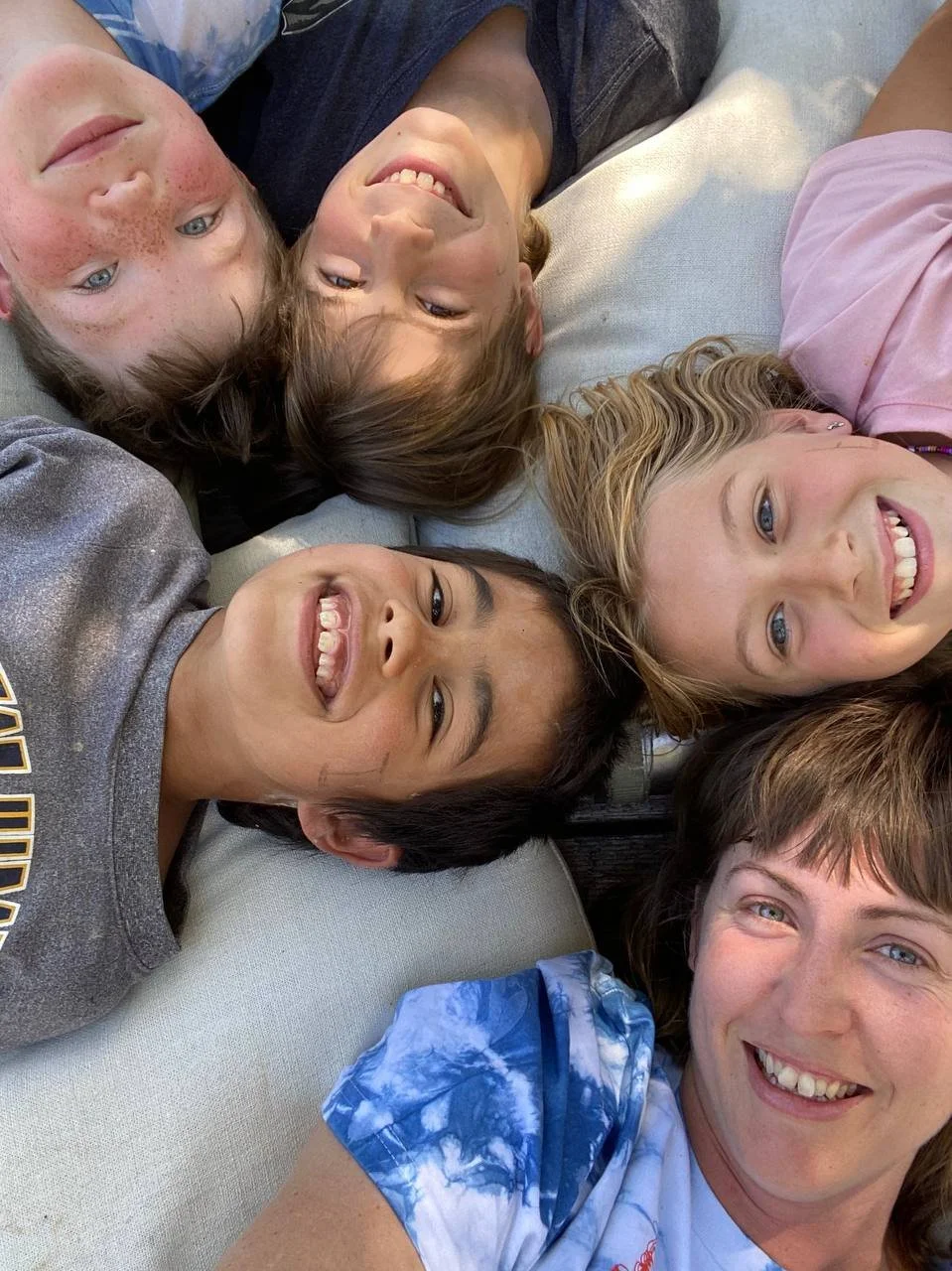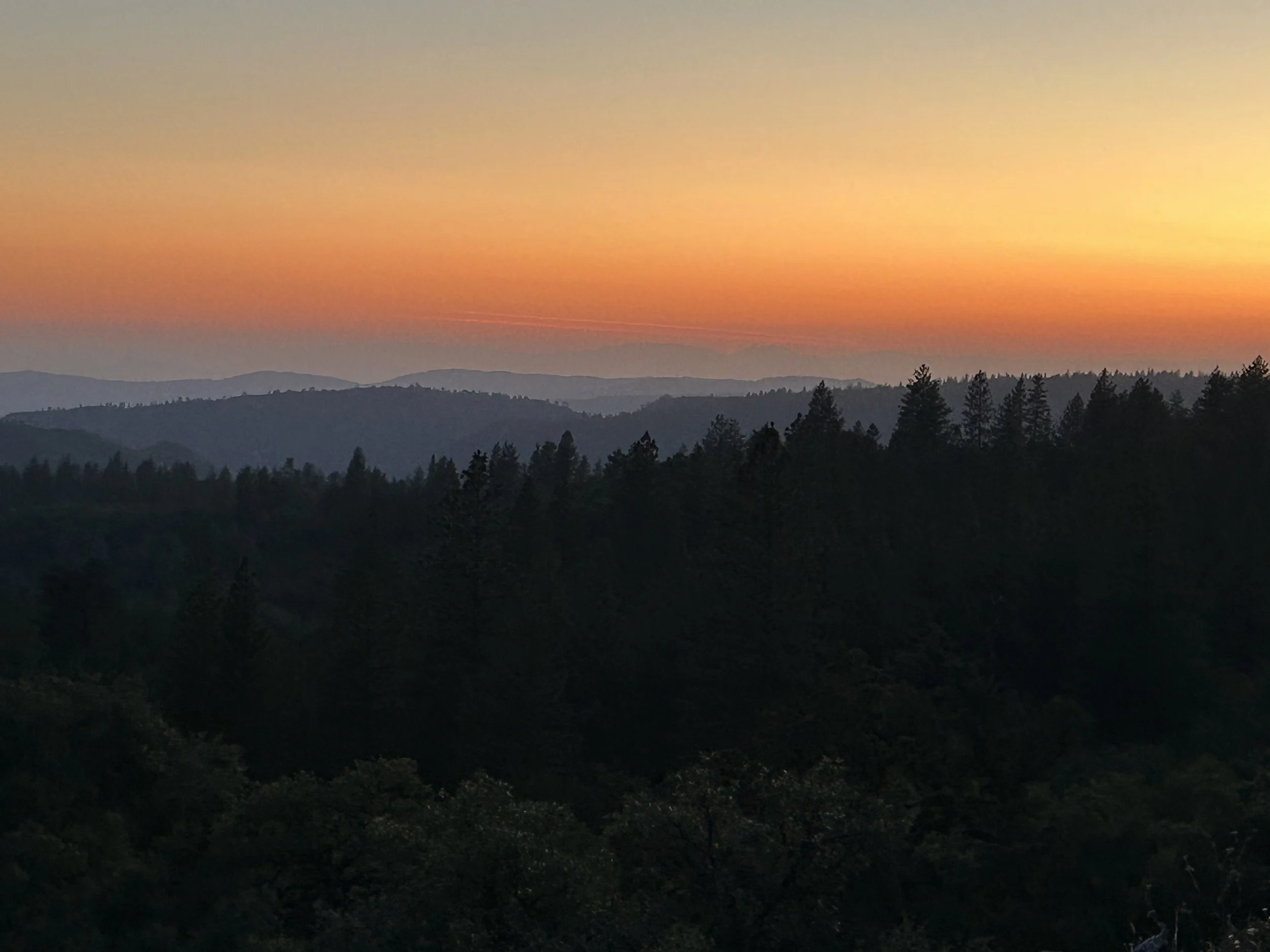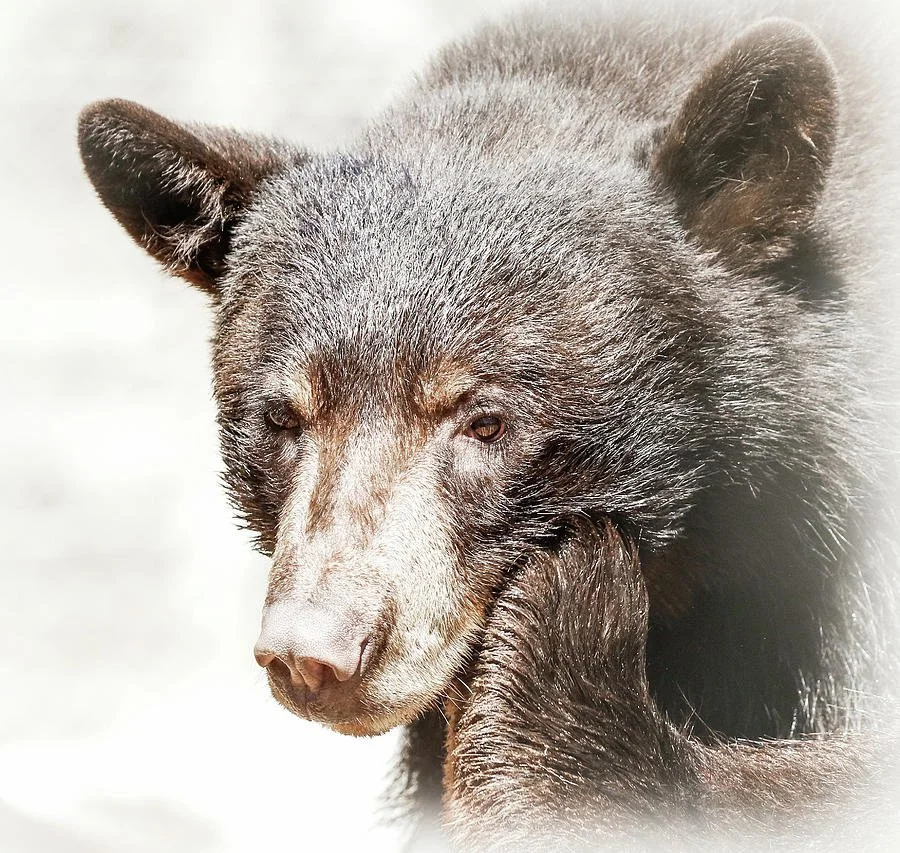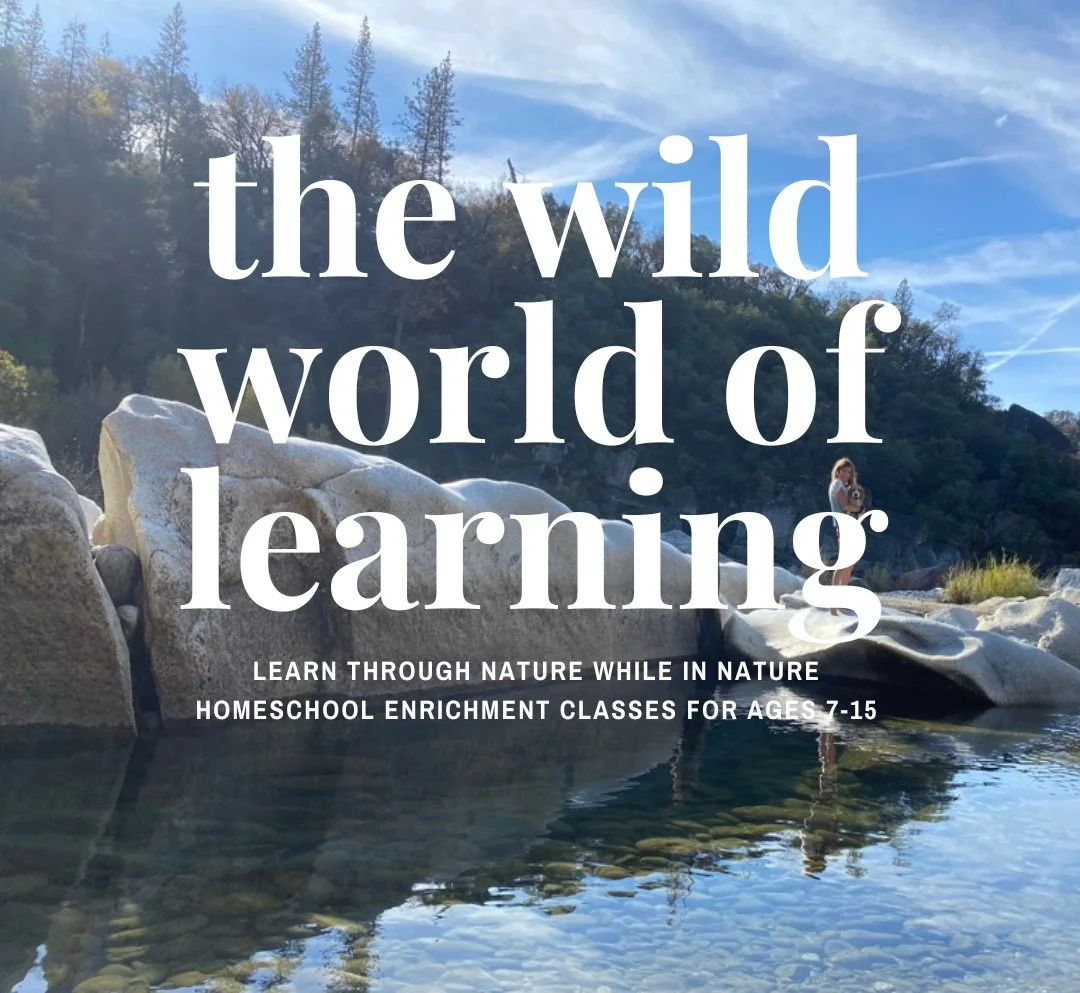June 2024
Happy Summer!
The Ohmapi Nature Project June 2024
This photo was taken during our end of the year campout in June 2024 featuring four of our fantastic students (Wendell, Malachite, Gavi, Elouise) and teacher Stacey.
Return of the Newsletter
Can you believe that it has been a year since the last newsletter? For real…I checked the files and last July was the last newsletter sent. There were several emails about programs and classes and such, but not a real newsletter in a whole year! Last year was a busy one. It was our highest enrollment yet. And, last year we added the all new elective day which meant a whole new group of students and teachers. It was an amazing year! Thank you students, parents and our Ohmapi team. There are a bunch of photos in this newsletter (scroll down) so you can see some of the things we did last year.
So…back to the newsletter. I really enjoy writing a newsletter. I like receiving newsletters too. Most email nowadays is sales and offers. When a real newsletter arrives in my inbox with real content, not just a sentence or two and then a link to the website, I really enjoy reading it. And so, my hope is that our newsletters are welcomed by others that still like getting real newsletters too.
Thus, we are re-committing to delivering regular newsletters. Members of the multi-faceted and talented Ohmapi community are invited to contribute to the newsletter writings too. And, incase you miss a newsletter, the same content will soon be posted in a blog that you will be able to access whenever you like.
Let’s start this newsletter, shall we…
In today’s newsletter
Summertime Musings
Summer Fun Quiz
The Main Lesson Story
2023-2024 in Pictures
Enrollment News
Summertime Musings
Rest is not idleness, and to lie sometimes on the grass under trees on a summer's day, listening to the murmur of the water, or watching the clouds float across the sky, is by no means a waste of time. — John Lubbock
What do you think about summer? Do you love it? Do you love that kids are out of school and you get to spend more time with them? Or do the kids complain that they “have nothing to do”? Do you love the heat ? Or do you dread the hot, dry days? Are vacations wonderful and relaxing? Or do you stress worrying about not working and the things that are not getting done?
And, do you wonder why kids get a summer break from school? There are many reasons…yet, the most widely accepted reason dates back to the start of public schools and how they were scheduled around work on the farm. Traditionally, schools were in session in the dead of winter and the heat of summer. Fall and spring were harvesting and planting seasons so the kids were needed on the farm and couldn’t attend school. Where as, summer and winter were slow on the farm so the kids could attend school.
Photo taken by myself in Nevada City on June 21….look at all those colors in the sky! Our Summer Solstice family tradition is to watch the sunset on the longest day of the year while eating strawberries and cream.
For many, winter solstice marks the end of the year and the beginning of a new one. To me, it is summer solstice that marks the end of the (school) year and beginning of the next (school) year. It is the time to reflect on the past year, write end of year reviews, sort and put away supplies. It is time to look at pictures of the year. And it is a time to make resolutions and set goals and dream of all the things we will do and study in the fall. And yet, it is also a time for summer break. Time to relax. Time to spend with family.
The days are longer and seemingly endless. There is so much to do and yet it feels like we have so much time in these long days to do it in. Per the quote above from John Lubbock, my wish is that everyone find a bit of idleness this summer!
Summer Fun Quiz..
1. How much water is in a watermelon?
a) 30%
b) 92%
c) 106%
5. True or False: The month of July is named after the Roman emperor Julius Caesar.
a) True
b) False
c) All of the Above
6. Which vitamin do you get from sunshine?
a) Vitamin A
b) Vitamin C
c) Vitamin D
7. When this star appears in the sky just before the Sun it marks the beginning of “the dog days of summer”. What is the name of this star?
a) Ursa Major
b) Cassiopeia
c) Sirius
Answers: b, a, c, c
The Main Lesson Story
Each year at Ohmapi, we have a nature focus from which all our lessons are based upon. Our nature focus for the 2024-2025 Academic Year is Fur, Feathers, Scales and Skin. Over the course of 33 in-class weeks, from September to June, we will explore the 8 locally found animals, including humans. Through our 4 week study on each animal we will seek to understand not only each animal’s behavior, habitat and biology but also its the cultural importance. Additionally, we will do month-long handwork projects to fully discover each animal’s unique characteristics.
And so that means this summer I am diving deep into all the animals we will explore! Oh my oh my, there is so much to learn before I can even begin writing lessons. I love the research part of my job. I love reading and learning new things about these animals that I have been learning about my whole life. Yes, for real, my “whole” life. For instance, we all learned something about bears from early on. One of our first fairy tales was likely about bears, perhaps Goldilocks and the Three Bears. Then as grade-school children, there were TV shows about pioneers and wildlife. And then, of course, there are dozens of sports teams with bears: Chicago, UCLA, etc.. And yet with all that familiarity, there is still so very much to know about bears. Did you know that bears are bowlegged? This gives them better grip and balance. And did you know that bears can run up to 40 miles per hour, fast enough to catch a running horse and about 2x as fast as humans? The fastest known human alive today, Usain Bolt, can run 27mph. Although I don’t think either of those, a bear nor Usain Bolt, can run at those speeds for a long time.
Black Bear Thinking Photograph by Athena Mckinzie
As part of my research, I read…a lot. And I watch videos and I listen to the books and podcasts. I devour information however, wherever I can.
Once I have gathered a ton of research, I begin story writing. For each animal, I will write 4 stories. Stacey will also write 4 stories. We will each write stories about their behavior, stories about their habitat, stories about their biology and stories about their cultural importance. And within each story, we often incorporate a pedagogical lesson. You may be wondering, why write stories when there are a ton of stories that already exist? And, of course now, we have ChatGPT where we could simply give it a few prompts and it writes the story for us. Sounds easy peasy, right? Story done…using either existing stories or AI and then…time to move onto lesson planning. That may sound like a good and easy plan but it’s not. It is neither a good nor easy plan. Here’s why…
After 11 years of leading a nature school, rarely do I find a story that conveys all the information that I need it to. On the rare instances when I do find one that is close, I still have to add to it. So, as odd as it may sound, most often, it is best, easiest and quickest to write a story. Yes, a 5 minute story that takes hours to write is “easiest”. One might think,“finding” an existing story is easiest. But it is not. It is easy to get sucked into endless hours searching for info online or reading stories in books only to find that I have to spend even more time editing and transforming the existing story into one that teaches what the students need to learn per our curriculum. And well, AI is AI and as someone that teaches about the real world and real connection between real humans, I struggle with the artificial part of artificial intelligence. There is a place for it, for sure, in this world, but that place is not in my story writing.
And so, not only is writing stories easiest and quickest, it is also best. It is best because I can make it meaningful and relevant to our students and our place. I teach through story because it speaks to the heart of the child. A list of facts about bears could be presented efficiently and it is likely that the first few facts will be retained by the learner, especially if they are dramatic or sensationalized. Yet, when I write and then tell a story about a bear there is a character to which the children can relate and there is a plot to follow; a plot and character to which all the facts (not just the first few sensationalized ones) about bears are linked making them memorable. Through story we can make facts retainable and interesting. For example, a fact might be that bears can see color. That, honestly, is not very memorable nor remarkable to even me so I can’t imagine a child would care to learn that fact if I mentioned it in a list of facts. Yet, a child may remember that bears are one of the few mammals that can see color if they hear in a story that George the Bear asks Daisy the Dog which flower she likes best, the red one or the yellow one, and Daisy doesn’t understand what George is talking about because to Daisy they both are yellow. (Dogs only see blues and yellows. Dogs can’t see red). By the time the kids hear that in the story, they are already connected to the personalities of Daisy and George and they care what happens to them. Now if I add some complexity to the story about George’s reaction to Daisy’s inability to differentiate color, then we can also teach a pedagogical lesson. Through story, children can learn about relationships, morals, community, resilience, tenacity and much more that help them become awesome humans. Like in the example above, perhaps the story continues and George seeks answers about their visual ability differences and discovers that hummingbirds can see ultraviolet colors and snakes can see heat and learns that many animals have different strengths; or perhaps George ridicules Daisy for her inability to differentiate between red and yellow; or perhaps George pities her for her perceived weakness. No matter how I choose to develop that story there is something the children will learn about relationships through the relationships of animals. And because they relate to George and Daisy’s personalities, they have feelings about their relationship and they will care how it is resolved. Plus, I can choose to modify the story as needed if there is perhaps a certain dynamic within our learning groups that needs to be addressed.
And so you can see why we write stories. A story can do so much, everything from conveying science facts to teaching pedagogical lessons, all in a way that speaks to the heart and is memorable.
After the writing the story, we do lesson planning. From each story, evolves a language arts, math, science and social science lesson. More on that in the future…
2023-2024 in Pictures
Check out the photos below of some of the many things we did last year in our 33 weeks of classes.
Last fall we began our studies with water critters and went on a field trip to the Bohart Museum of Entomology in Davis, CA.
During our worm block we dissected a worm, made a worm compost bin, invited a local entomologist to spend the day and teacher Stacey, as an acorn weevil larva, wiggled out of an “acorn”.
Our fall festivals included our annual lantern walk and a Dia de los Meurtos celebration.
During our end of the year campout, we went fishing in the wee hours of the morning. About 10 kids eagerly woke up at 5am and walked a 1/2 mile to the pond. Some of the kids had poles and lures. Some did not. For the ones that did not, we tied a bit of fishing line to a stick, added a hook and stuck a bit of brick cheese onto the hook. Annabelle, above, caught the most fish that morning, 8, on said stick.
By November we hit our stride with games, lesson and friendships.
December was the bees block. We went on a field trip to a local bee keeper. Our holiday party and advent spiral is a lovely way to come together before a 3 week winter break.
One of the highlights of the year was our trip to the snow. Almost 30 of us sledding and making snow forts for the whole day!
And before you know it, it was spring and we were back to wearing shorts and swimming in the water!
Enrollment News
Our Fall 2024 Classes start on September 9. We are now accepting applications for all grades.
At Ohmapi, our students learn through nature while in nature as we weave academics into our nature studies. Students learn math, language arts, science and history/geography everyday in our Waldorf-inspired main lessons. Equally important to lesson time, is the time we spend exploring nature, solving riddles, playing games, listening to stories, learning through doing, making observations and doing handwork.
We offer several enrollment options: 3 day per week Academic Nature Program, 2 day per week Specialty Subject Program and 5 day per week Academic + Specialty Subject Program. More info can be found on the website.
To learn more and meet our team, join us for one of our Prospective Parent Meetings on July 14 or August 4 from 10am - Noon. Please RSVP for details and meeting location.
Summer Camps
It’s not too late to enroll in our many summer camp offerings!…Summer camps are a good way to see if Ohmapi is good fit for your family. Contact us to arrange a trial day during any one of our summer camps.
Ohmapi Around Town…
This summer you can find us regularly around town at Farmer’s Market and The Full Circle Garden. In August, we will be at Nevada County Fair. Be sure to stop by and say, “Hi”.













